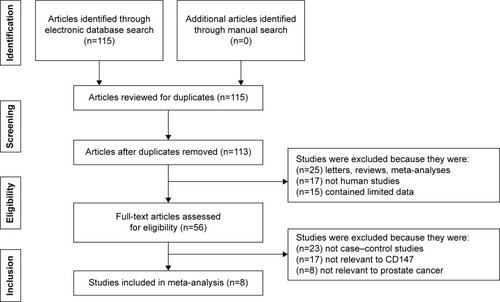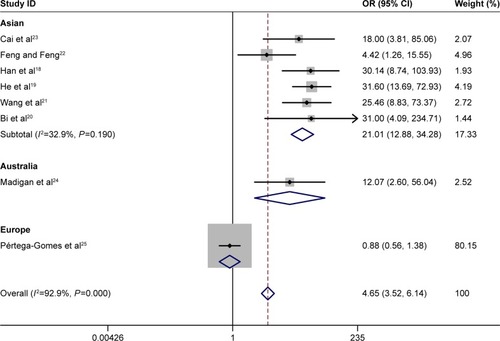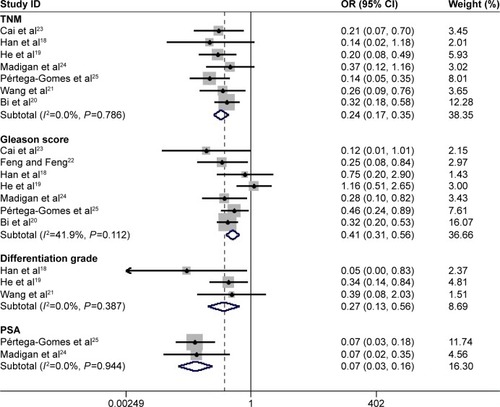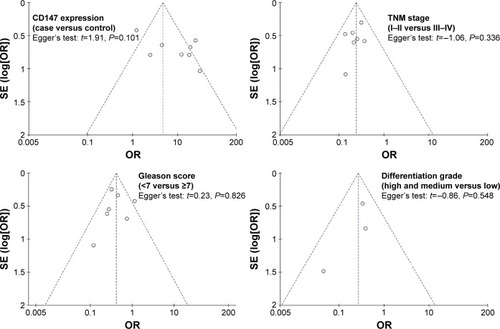Abstract
Background
There are a number of studies which show that expression of CD147 is increased significantly in prostate cancer (PCa). However, conflicting conclusions have also been reported by other researchers lately. In order to arrive at a clear conclusion, a meta-analysis of eligible studies was conducted.
Materials and methods
We searched PubMed, MEDLINE, Cochrane Library, and the China National Knowledge Infrastructure databases to identify all the published case–control studies on the relationship between the expression of CD147 and PCa until February 2016. In the end, a total of 930 patients in eight studies were included in the meta-analysis.
Results
CD147 expression in the PCa patients increased significantly (odds ratio [OR], 4.65; 95% confidence interval [CI], 3.52–6.14; Z=10.79; P<0.05), but there was obvious heterogeneity between studies (I2=92.9%, P<0.05). Subgroup analysis showed that positive expression of CD147 was associated with PCa among the Asian population (OR, 21.01; 95% CI, 12.88–34.28; Z=12.19; P<0.05). Furthermore, it was significantly related to TNM stage (OR, 0.24; 95% CI, 0.17–0.35; Z=7.74; P<0.05), Gleason score (OR, 0.41; 95% CI, 0.31–0.56; Z=5.62; P<0.05), differentiation grade (OR, 0.27; 95% CI, 0.13–0.56; Z=3.47; P<0.05), and pretreatment serum prostate-specific antigen level (OR, 0.07; 95% CI, 0.03–0.16; Z=6.47; P<0.05).
Conclusion
Positive expression of CD147 was related to PCa, significant heterogeneity was not found between Asian studies, and the result became more significant. The positive expression of CD147 was significantly related to the clinicopathological characteristics of PCa. This suggests that CD147 plays an essential role in poor prognosis and recurrence prediction.
Keywords:
Introduction
Prostate cancer (PCa) is a common malignant tumor in the urogenital system of men, which seriously threatens men’s health and becomes an important cause of death in elderly men, and the mortality rate is the second highest among men worldwide.Citation1,Citation2 With the gradual increase of the aging population and the constant increase in the level of clinical diagnosis, morbidity due to PCa has increased greatly. Due to the long duration of its course and the lack of early specific clinical symptoms, the diagnosis, treatment, and prognosis of disease are seriously affected. It is therefore clinically essential to diagnose the condition early, evaluate the degree of malignancy, and improve the prognosis for PCa.
As a member of the immunoglobulin family, extracellular matrix metalloproteinase inducer (EMMPRIN, also known as CD147) is a glycoprotein enriched on the surface of many tumor cells.Citation3,Citation4 CD147 has been demonstrated to participate in different ways in tumor invasion and metastasis by stimulating the synthesis of matrix metalloproteinases (MMPs).Citation5 There are some studies regarding the relationship between CD147 and PCa, and the results show that positive expression of CD147 is significantly higher in PCa patients compared to controls.Citation6,Citation7 As a result, it is reasonable to speculate that expression of CD147 may be closely related to the pathogenesis of PCa. However, inconsistent results have also been reported by other studies.Citation8,Citation9 Because such a discrepancy exists among previous studies, a systematic review was conducted to explore the correlation between CD147 expression and PCa, in addition to determining its clinicopathological characteristics.
Materials and methods
Search strategy
This meta-analysis was carried out in accordance with the guidelines of the Meta-analysis of Observational Studies in Epidemiology (MOOSE) group.Citation10 We conducted a comprehensive search of PubMed, MEDLINE, Cochrane Library, and the China National Knowledge Infrastructure databases until February 2016. The following search strategy was used: (“CD147” OR “Extracellular matrix metalloproteinase inducer” OR “EMMPRIN”) and (“prostate cancer” OR “PCa” OR “prostatic neoplasm” OR “prostate neoplasm” OR “cancer of the prostate” OR “prostatic cancer”). Subsequently, the eligible literature was included for further screening.
Study selection
Two researchers independently screened the eligible literature. The following criteria for study inclusion were used: it should be a case–control study; the authors had to measure CD147 expression of tumor tissue by immunohistochemical method; and the association between CD147 expression and PCa should be reported. Simultaneously, the exclusion criteria were as follows: animals were used; reviews, comments, and irrelevant articles; and the data comprised continuous variables or were incomplete.
Data extraction
The following items were collected from the included studies: the first author’s name, publication year, country in which the study was performed, study type, study design, sample size, age, ethnicity, detection method for CD147 expression, expression of CD147 in PCa patients with different TNM stages, differentiation grade, and Gleason score.
Study quality
According to the Newcastle–Ottawa Scale (NOS) for case–control studies,Citation11 two independent authors (YY and S-LL) evaluated the quality of the included studies. The included studies were respectively classified into two levels: low quality (0–6), and high quality (7–9).Citation12 When discrepancies of the enrolled studies existed, a third investigator (YW) was invited to adjudicate.
Statistical analysis
Heterogeneity was defined as a consequence of methodological and/or statistical diversity among the studies.Citation13 Cochran’s Q-statistic test was used to analyze the heterogeneity (P-values <0.05 were treated as statistically significant).Citation14 I2 test was also used to detect the heterogeneity between studies, the values of which ranged from 0% (no heterogeneity) to 100% (maximal heterogeneity).Citation15 I2 values of 25%, 50%, and 75% represented low, medium, and high heterogeneity.Citation16 Sensitivity analysis was conducted to validate the credibility of outcomes through deletion of individual studies in the meta-analysis. Funnel plot was explored to identify whether there was any evidence of publication bias. Symmetry of the funnel plots was further evaluated by Egger’s linear regression test.Citation17 To calculate the effect size for clinicopathological characteristics, the summary odds ratios (ORs) with their 95% confidence intervals (CIs) were used for TNM stages I–II versus TNM stages III–IV, high- and medium-differentiation grade versus low-differentiation grade, Gleason score <7 versus ≥7, and low prostate-specific antigen (PSA) level (<10 ng/mL) versus high PSA level (≥10 ng/mL) categories of CD147 expression. We conducted a subgroup meta-analysis to explore the potential effect of ethnicity. Statistical analyses were carried out using the statistical software Stata version 12.0 (StataCorp LP, College Station, TX, USA) with a two-sided test. All tests were two sided, and a P-value of 0.05 was regarded as statistically significant.
Results
Literature search
The details of the study search are presented in a flow diagram (). In total, 115 relevant studies were identified. After carefully reading the articles, we excluded 47 studies because they were duplicates, letters, reviews, nonhuman studies, or contained limited data. Following the reading of the remaining studies, additional studies were excluded because they were not case–control studies and because they were not relevant to CD147 or PCa. Finally, eight case–control studies were included in the meta-analysis. The selection process is shown in .
Study characteristics
The characteristics of the selected studies are listed in . Eight studies were published between 2008 and 2015: six studies from Asia,Citation18–Citation23 one from Australia,Citation24 and one from Europe.Citation25 Furthermore, we compared the rate of positive expression of CD147 between the following pairs: Gleason score <7 and Gleason score ≥7 groups (seven studies); TNM I+II and TNM III+IV groups (seven studies); high- and medium-differentiation and the low-differentiation groups (three studies), and low and high PSA level groups (two studies). The median NOS score of seven was identified as a reliable quality.
Table 1 Characteristics of the eligible studies included in the meta-analysis
Meta-analysis
Correlation between CD147 expression and PCa
We compared the rate of positive expression of CD147 in the eight included studies. The pooled OR was 4.65 (95% CI, 3.52–6.14; Z=10.79; P<0.05) and there was evidence of heterogeneity between studies (I2=92.9%, P<0.05) ().
Subgroup analysis
We used subgroup analyses to explore heterogeneity. Subgroup analysis based on ethnicity implied that positive expression of CD147 was related to PCa in the Asian population (OR, 21.01; 95% CI, 12.88–34.28; Z=12.19; P<0.05) ().
Association between positive expression of CD147 and clinicopathological characteristics of PCa
We compared the rate of positive expression of CD147 between the TNM I+II and TNM III+IV stages in seven studies. The pooled OR was 0.24 (95% CI, 0.17–0.35; Z=7.74; P<0.05), with no significant heterogeneity (I2=0%, P=0.79). In addition, the rate of positive expression of CD147 between the groups with Gleason scores <7 and ≥7 was compared in seven studies. The pooled OR was 0.41 (95% CI, 0.31–0.56; Z=5.62; P<0.05), with no significant heterogeneity (I2=42%, P=0.11). Furthermore, CD147 was more highly expressed in PCa patients with high differentiation grade in three studies (OR, 0.27; 95% CI, 0.13–0.56; Z=3.47; P<0.05), and no evidence of heterogeneity was detected (I2=0%, P=0.39). The results also suggest that CD147 was more highly expressed in PCa patients with high PSA level in two studies (OR, 0.07; 95% CI, 0.03–0.16; Z=6.47; P<0.05), with no evidence of heterogeneity (I2=0%, P=0.95) (). Therefore, the positive expression of CD147 was associated with the clinicopathological characteristics of PCa patients.
Publication bias and sensitivity analysis
The overall statistical significance did not change when any single study was omitted. Sensitivity analysis shows that data are relatively stable and credible (). The funnel plots of the studies were symmetrical, and Egger’s test showed no publication bias (). As the number of included studies that investigated the relation between PSA level and CD147 expression was <3, we did not carry out publication bias and sensitivity analyses.
Discussion
PCa is the most common malignant tumor of the male reproductive system and its incidence is ranked the second in the world. A projected 180,890 new cases of PCa will be diagnosed and an estimated 26,120 men may die of the disease in the USA alone in 2016. The mortality due to PCa accounts for 8% of all cancer deaths.Citation26 The incidence of this disease has obvious heterogeneous geographical and ethnic characteristics, and prognosis presents a different scenario according to the operation method, pathological type, tumor stage, and other factors.Citation27 For these reasons, we need precise biological indicators to guide treatment and monitor the progress of disease in PCa patients.
Positive expression of CD147 was found in many cancer tissues, which is related to poor prognosis for the patient.Citation28–Citation31 Some studies showed that CD147 plays an essential part in the progression and metastasis of PCa.Citation7,Citation32 However, other relevant studies have reported contradictory findings.Citation8,Citation9 Additionally, there is no relevant meta-analysis that reports the relationship between CD147 expression and PCa so far. Therefore, we conducted the present meta-analysis to explore the relationship between expression of CD147 and PCa.
We included 930 cases and 366 controls of eight studies in this meta-analysis. The pooled OR was 4.65 (95% CI, 3.52–6.14; Z=10.79; P<0.05), indicating that CD147 expression was associated with PCa. However, there was obvious heterogeneity between the studies (I2=92.9%, P<0.05). Additionally, subgroup analysis based on ethnicity suggests that positive expression of CD147 was associated with PCa in the Asian population (OR, 21.01; 95% CI, 12.88–34.28; Z=12.19; P<0.05). There was no obvious heterogeneity between the studies conducted in Asian populations, and the result became more significant (I2=33%, P=0.19). This indicates that the heterogeneity is derived from ethnicity.
Pretreatment clinical TNM staging, Gleason score, differentiation grade, and serum PSA level are clinicopathological characteristics of PCa, which can indicate the prognosis of patients and have an important clinical value in determining PCa. We calculated the effect size for clinicopathological characteristics. There was no significant heterogeneity and we found that the association between clinicopathological characteristics of PCa and positive expression of CD147 is significant. It suggests that CD147 plays an important role in poor prognosis and prediction of PCa recurrence.
Riethdorf et alCitation33 analyzed the incidence of CD147 expression in different tumor types and found a remarkable difference in CD147 expression levels. Another investigation of expression and function of CD147 as a cancer-associated biomarker showed the following incidence rates of CD147 expression in various cancers: cancers of the liver (80%), prostate (80%), lung (62%), stomach (66%), colon (58%), rectum (59%), breast (64%), brain (90%), esophagus (87%), ovary (75%), urinary bladder (85%), and skin (58%).Citation34 These results can render CD147 as the therapeutic target in a broad range of cancer types and could be used for differential diagnosis.
Based on the current results of meta-analysis, we assume that the expression of CD147 is a clinical biomarker for PCa, which could affect the clinicopathological characteristics of PCa. Nevertheless, certain limitations of our study should be considered. First, continuous variable data were not included in this study. Second, the included studies were limited to those written in Chinese or English. Third, the majority of the included studies were conducted in the Asian population.
Conclusion
Positive CD147 expression may be related to PCa and deterioration in terms of the clinicopathological characteristics of PCa. CD147 could serve as a biomarker for the diagnosis and prognosis of PCa patients. We should conduct further investigations to evaluate the role of CD147 expression in PCa.
Acknowledgments
This study was supported by the Education Department of Shaanxi Provincial Government (11JK0723) and the First Affiliated Hospital of Xi’an Medical University (XYFY14-02). The authors express their gratitude to the study participants and research personnel for their involvement in the study. They would also like to thank Professor Ming Xie and Professor Yuqiang Ji for their valuable assistance.
Disclosure
The authors report no conflicts of interest in this work.
References
- FerlayJShinHRBrayFFormanDMathersCParkinDMEstimates of worldwide burden of cancer in 2008: GLOBOCAN 2008Int J Cancer2010127122893291721351269
- SiegelRLMillerKDJemalACancer statistics, 2015CA Cancer J Clin20156552925559415
- ZengHZQuYQLiangABExpression of CD147 in advanced non-small cell lung cancer correlated with cisplatin-based chemotherapy resistanceNeoplasma201158544945421745000
- NagashimaSSakuraiKSuzukiSCD147 expression in noninvasive and invasive breast carcinomaGan To Kagaku Ryoho2014411267126925335713
- GrassGDTooleBPHow, with whom and when: an overview of CD147-mediated regulatory networks influencing matrix metalloproteinase activityBiosci Rep2015361e0028326604323
- ZhuHZhaoJZhuBEMMPRIN regulates cytoskeleton reorganization and cell adhesion in prostate cancerProstate2012721728121563192
- Bilgin DoğruEDizdarYAkşitEUralFŞanlıÖYasaseverVEMMPRIN and ADAM12 in prostate cancer: preliminary results of a prospective studyTumour Biol20143511116471165325139103
- BaumanTMEwaldJAHuangWRickeWACD147 expression predicts biochemical recurrence after prostatectomy independent of histologic and pathologic featuresBMC Cancer20151554926209327
- GruppKHohneTSPrienKReduced CD147 expression is linked to ERG fusion-positive prostate cancers but lacks substantial impact on PSA recurrence in patients treated by radical prostatectomyExp Mol Pathol201395222723423948277
- StroupDFBerlinJAMortonSCMeta-analysis of observational studies in epidemiology: a proposal for reporting. Meta-analysis of observational studies in epidemiology (MOOSE) groupJAMA20002832008201210789670
- StangACritical evaluation of the Newcastle-Ottawa scale for the assessment of the quality of nonrandomized studies in meta-analysesEur J Epidemiol20102560360520652370
- ZhangPZhongZHYuHTLiuBSignificance of increased leptin expression in osteoarthritis patientsPLoS One2015104e012322425893833
- HigginsJPTGreenSCochrane Handbook for Systematic Reviews of Interventions 4.2.6 [updated September 2006]. Available from: http://www.cochrane.org/resources/handbook/hbook.htmAccessed April 26, 2016
- JacksonDWhiteIRRileyRDQuantifying the impact of between-study heterogeneity in multivariate meta-analysesStat Med201231293805382022763950
- PetersJLSuttonAJJonesDRAbramsKRRushtonLComparison of two methods to detect publication bias in meta-analysisJAMA200629567668016467236
- HigginsJPThompsonSGDeeksJJAltmanDGMeasuring inconsistency in meta-analysesBMJ200332755756012958120
- ZintzarasEIoannidisJPHEGESMA: genome search meta-analysis and heterogeneity testingBioinformatics200521183672367315955784
- HanZDBiXCQinWJCD147 expression indicates unfavourable prognosis in prostate cancerPathol Oncol Res200915336937419048397
- HeHCHanZDDaiQSExpression and significance of CDl47 protein inprostate cancerZhonghua Yi Xue Za Zhi2009891844184619953931
- BiXCLiuJMZhengXGOver-expression of extracellular matrix metalloproteinase inducer in prostate cancer is associated with high risk of prostate-specific antigen relapse after radical prostatectomyClin Invest Med2011346E35822129926
- WangQZhangJGWangWExpression and significance of S100P, CD147, and OCT4 in different prostate cancer tissue TNM stagesGenet Mol Res2015146844685126125892
- FengMEFengLTo investigate the expression of the STAT3 and CD147 in human prostate cancerJ Nanchang Univ2010501215
- CaiCYWuCYYangYFLiSRShiXMExpression and clinical significance of CD147 protein in human prostate cancerJ Clin Res20153220882090
- MadiganMCKingsleyEACozziPJDelpradoWJRussellPJLiYThe role of extracellular matrix metalloproteinase inducer protein in prostate cancer progressionCancer Immunol Immunother20085791367137918273614
- Pértega-GomesNVizcaínoJRMiranda-GonçalvesVMonocarboxylate transporter 4 (MCT4) and CD147 overexpression is associated with poor prognosis in prostate cancerBMC Cancer20111131221787388
- SiegelRLMillerKDJemalACancer statistics, 2016CA Cancer J Clin20166673026742998
- BoydLKMaoXLuYJThe complexity of prostate cancer: genomic alterations and heterogeneityNat Rev Urol201291165266423132303
- MonteiroLSDelgadoMLRicardoSEMMPRIN expression in oral squamous cell carcinomas: correlation with tumor proliferation and patient survivalBiomed Res Int2014201490568024967412
- KongLMLiaoCGZhangYA regulatory loop involving miR-22, Sp1, and c-Myc modulates CD147 expression in breast cancer invasion and metastasisCancer Re2014741437643778
- AfonsoJLongatto-FilhoABaltazarFCD147 overexpression allows an accurate discrimination of bladder cancer patients’ prognosisEur J Surg Oncol201137981181721733655
- XueYJLuQSunZXCD147 overexpression is a prognostic factor and a potential therapeutic target in bladder cancerMed Oncol20112841363137220509007
- ZhongWDLiangYXLinSXExpression of CD147 is associated with prostate cancer progressionInt J Cancer201213030030821328337
- RiethdorfSReimersNAssmannVHigh incidence of EMMPRIN expression in human tumorsInt J Cancer20061191800181016721788
- LiYXuJChenLHAb18G (CD147), a cancer-associated biomarker and its role in cancer detectionHistopathology200954667768719438743






